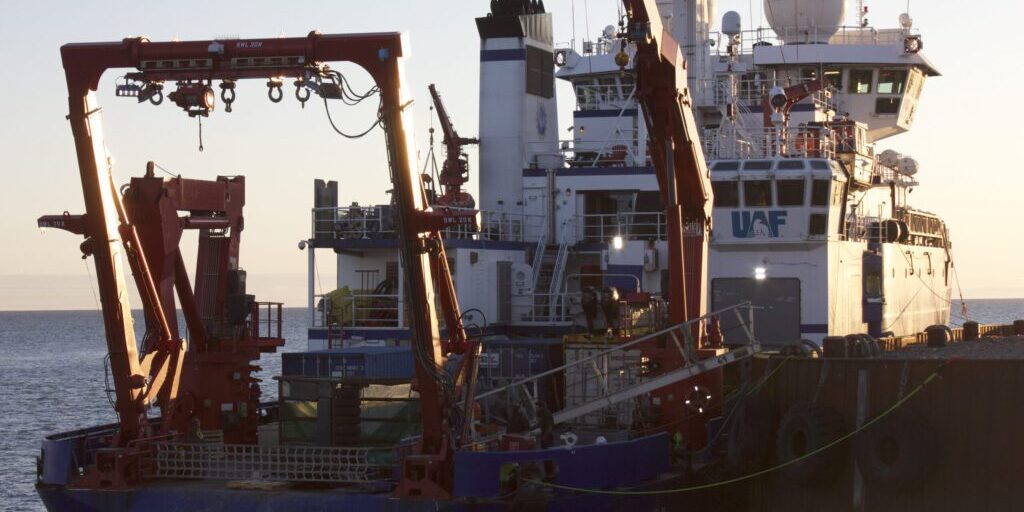Sea ice forming in the Chukchi and Beaufort Seas is starting to close in on Utqiagvik, leaving a lot of open water currently through the Bering Strait. One research cruise taking advantage of the favorable sailing conditions with little ice in Arctic waters, is the Sikuliaq, a University of Alaska Fairbanks vessel.
Several scientists onboard the vessel are studying how a variety of conditions are changing in Arctic waters during the autumn. One researcher refers to the current Chukchi and Beaufort Sea ecosystems as the “new Arctic”.
“And by the new Arctic I mean the Arctic with a lot less ice, and a really, really late return of the ice, so those are the key things.”
– Jim Thomson
According to Jim Thomson, senior oceanographer on the Sikuliaq, from 1979-2014, sea ice returning to the Beaufort and Chukchi Seas each autumn has gradually come back later and later.
“And there’s a trend that’s about one day per year, one day per year later. So over the course of three decades, that’s about a month. This is something that we published a few years ago when we thought ‘yeah the freeze up is about a month later.’ Well things appear to have accelerated a fair bit and now the freeze up in some cases this year feels like it could be two months later depending on how you count it, so it’s a lot later.”
– Jim Thomson
Thomson says with delayed sea ice return; open water is present in the Chukchi and Beaufort Seas later into the fall. The fall season also brings storm activity to the region, and those storms plus more open water equals increased wave action, as Thomson explains.
“And so that open water space, we call that the fetch. That’s the space over which waves can grow when there’s wind and if there’s more fetch for the same amount of wind, there’s more waves.”
In general, wave height is also increasing in these Arctic waters along with wave energy. According to Thomson if this trend continues, as a current feedback loop, then more coastline around the Beaufort and Chukchi Seas could be eroded and infrastructure could be threatened by more damaging storm events. So, during this month’s research venture, Thomson and his team will observe areas closer to the coastline and gather data on wave action.
As Thomson is aboard the Sikuliaq for that study, another group on-deck will be focusing on an ecosystem change in the “new Arctic”: what’s going on with Arctic cod’s movement and where are they coming from.
Hauke Flores says his study in the Beaufort and Chukchi Seas will focus on one-year-old Arctic cod, which he refers to as Polar cod.
“Polar cod is a small fish that is the staple food of the seals, and in this region especially the Beluga whales. And in that way, it really is a cornerstone of the Arctic food web. So without Polar cod, everything else doesn’t work anymore.”
– Hauke Flores
Flores and his fellow researcher Franz Mueter suggest that the Arctic cod follow the sea ice when they migrate north into the Northern Bering Sea, but where the younger fish start from and where they go afterwards is harder to determine.
“And where they go after this, we don’t really understand yet, and that’s part of the reason why we’d like to see if they maybe associate with the ice as it forms. They are probably going to drift around the corner into the Beaufort Sea or to the west in the Chukchi Sea. And what we’re interested in is if they are deeper in the water column, and if so, do they come up under the ice as the ice forms?”
– Franz Mueter
According to Mueter, temperature alone may not be driving Arctic cod further north in large concentrations. Instead he theorizes that their movements are driven by the presence of predators in the Northern Bering, the Chukchi, and the Beaufort seas.
The Sikuliaq will be out at sea until end of November and researchers anticipate it will be at least a year before they can release their findings.
According to Thomson, they plan to be back in the Bering Strait region next year.
Image at top: The UAF research vessel Sikuliaq docked in the Port of Nome. Photo from Davis Hovey, KNOM (2019).




